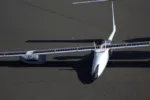The U.S. Air Force’s ambitious Collaborative Combat Aircraft (CCA) program has hit a turbulence point as Anduril Industries’ first flight of its CCA prototype is likely to be delayed due to federal budgetary uncertainty and the threat of a government shutdown. The delay highlights the fragility of rapid acquisition efforts in contested fiscal environments and raises questions about the timeline for fielding AI-enabled unmanned combat air vehicles (UCAVs) under the Next-Generation Air Dominance (NGAD) framework.
Anduril’s Role in the CCA Program
Anduril Industries was one of several companies awarded contracts under the U.S. Air Force’s CCA initiative—part of the broader NGAD ecosystem aimed at developing autonomous or semi-autonomous drones to fly alongside manned fighters like the F-35 and future sixth-generation aircraft. These drones are envisioned as force multipliers capable of executing ISR, electronic warfare (EW), strike missions, or acting as decoys—all while being cheaper and more expendable than manned platforms.
In August 2023, Anduril confirmed it had been selected for a Phase 2 contract under the CCA program. This phase includes building and flying full-scale demonstrators. While specific technical details remain classified or proprietary, Anduril has emphasized its focus on software-defined autonomy and modular open systems architecture (MOSA), aligning with DoD priorities for rapid iteration and adaptability.
First Flight Timeline Slipping
According to recent reporting by Air & Space Forces Magazine, Anduril had originally planned to conduct its first flight test of its CCA demonstrator in early 2024. However, company officials now indicate this timeline is slipping—largely due to delayed appropriations from Congress and uncertainty surrounding fiscal year 2024 defense funding.
This delay is not unique to Anduril; other contractors involved in CCA development—including Kratos Defense and Boeing—are also closely watching Capitol Hill for signs of budget resolution. The potential for a continuing resolution (CR) or full government shutdown could freeze new-start programs like CCA in their tracks.
Impact of Continuing Resolutions on Rapid Acquisition
The Department of Defense (DoD) has long warned that CRs disproportionately harm emerging technology programs that rely on timely funding tranches to meet aggressive development schedules. Under a CR, agencies are typically restricted from initiating new programs or increasing production rates—effectively stalling efforts like NGAD’s unmanned wingmen.
For companies like Anduril that pride themselves on Silicon Valley-style agility and speed-to-field capabilities, such bureaucratic slowdowns undermine their core value proposition. “We can move fast,” said an Anduril spokesperson, “but only if we’re funded.” The company reportedly has test articles nearing readiness but cannot proceed without clear budget authority from Congress.
The Strategic Stakes: Why CCAs Matter
The stakes are high for maintaining momentum on CCAs. These autonomous aircraft are central to USAF plans for distributed airpower in contested environments—especially against peer adversaries like China where attritable mass and survivable autonomy could tip operational balances.
The USAF envisions fielding hundreds of CCAs by the early 2030s at unit costs between $10–25 million per aircraft—far less than manned fighters but still capable of sophisticated missions via onboard AI and networked coordination with human pilots. The service aims to select one or more vendors for production contracts by FY2026 following a fly-off between competing demonstrators starting in FY2025.
Key Features Expected from CCA Platforms:
- AI-enabled autonomy with minimal human oversight
- MOSA-compliant avionics for rapid upgrades
- Low-observable designs suitable for contested airspace
- Payload modularity: EW pods, sensors, kinetic weapons
- Tactical data link integration with F-35/NGAD platforms
DARPA Influence and Industry Competition
The roots of today’s CCA effort trace back to DARPA’s “Loyal Wingman” concepts such as Skyborg and Gremlins—which explored teaming manned fighters with autonomous drones using shared mission planning frameworks. While those early programs yielded mixed results technically, they laid groundwork for today’s more mature efforts under NGAD.
Alongside Anduril, Kratos is leveraging its XQ-58A Valkyrie platform—which has already flown multiple times—as a possible foundation for its offering. Boeing is also believed to be adapting technologies from its MQ-28 Ghost Bat developed with Australia. Northrop Grumman reportedly declined participation earlier in Phase 1 bidding but may re-enter depending on future solicitations.
What Happens Next?
If Congress passes a full-year defense appropriation before March 2024—a scenario viewed as increasingly unlikely given political gridlock—the delays could be minimized or reversed quickly. However, if another CR or shutdown occurs in early 2024, it may push all timelines back several quarters across vendors.
The USAF remains committed publicly to fielding CCAs within this decade but acknowledges that schedule risk is rising amid fiscal instability. Brigadier General Dale White (PEO for Fighters & Advanced Aircraft) recently emphasized that “speed matters” but cautioned that industry must be ready to absorb shocks without compromising safety or mission assurance during flight testing phases.
Potential Implications:
- Pushed-back flyoff dates could compress evaluation windows before vendor downselects
- Lagging test data may reduce confidence in AI performance metrics under real-world conditions
- Sustained delays risk ceding technological advantage in UCAV autonomy to near-peer competitors like China’s AVIC Wing Loong-X programs
Conclusion: Innovation Meets Bureaucracy Again
The delay in Anduril’s first flight underscores a persistent tension between innovation timelines promised by defense startups and the realities of federal budgeting cycles. As next-gen air dominance hinges increasingly on unmanned teaming concepts like CCAs—and as adversaries accelerate their own drone swarms—the cost of delay may not just be financial but strategic.
If policymakers wish to retain competitive advantage through initiatives like NGAD and JADC2 integration efforts involving autonomous systems, then insulating these programs from recurring fiscal disruptions will be essential—not optional.










